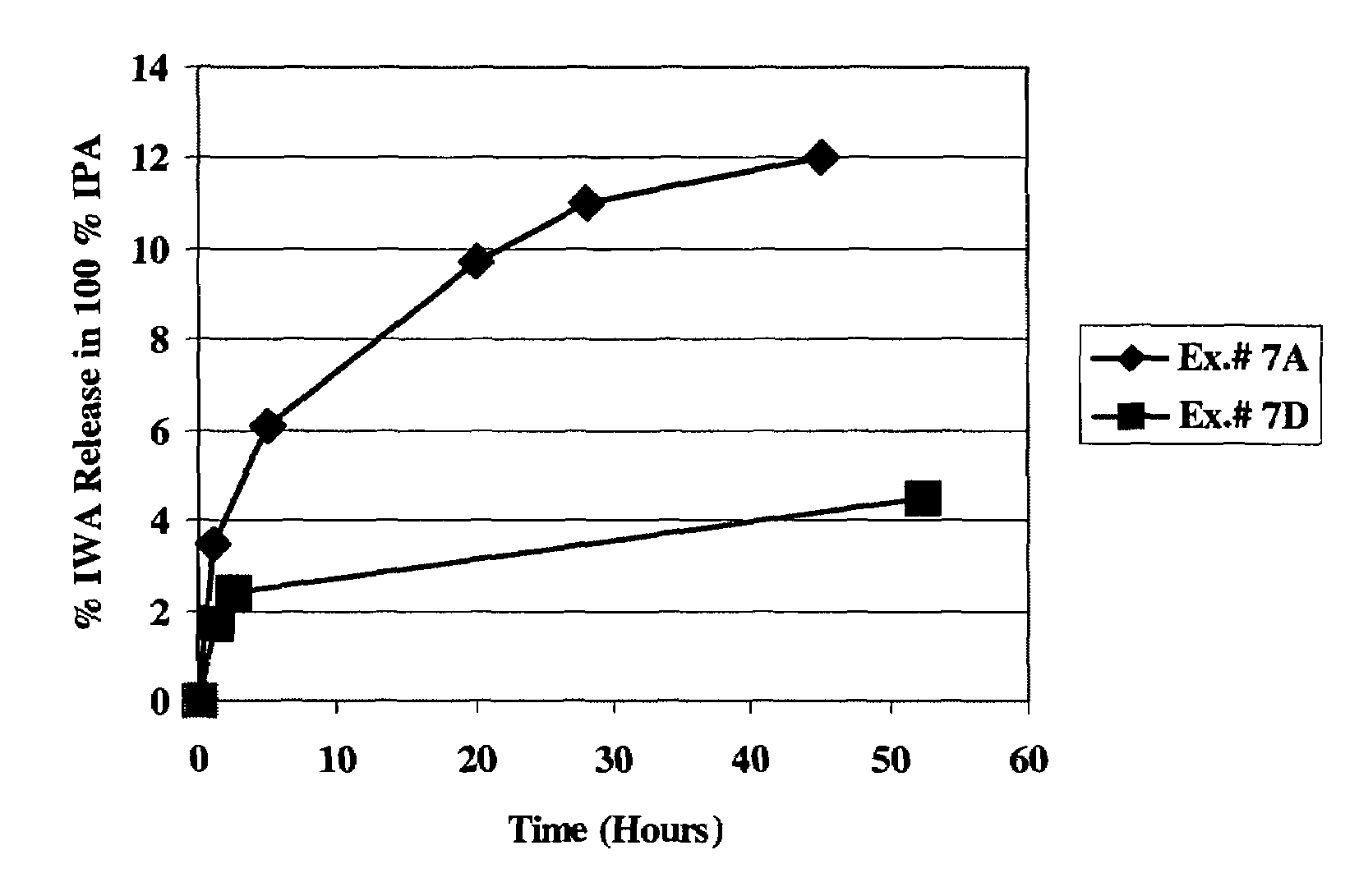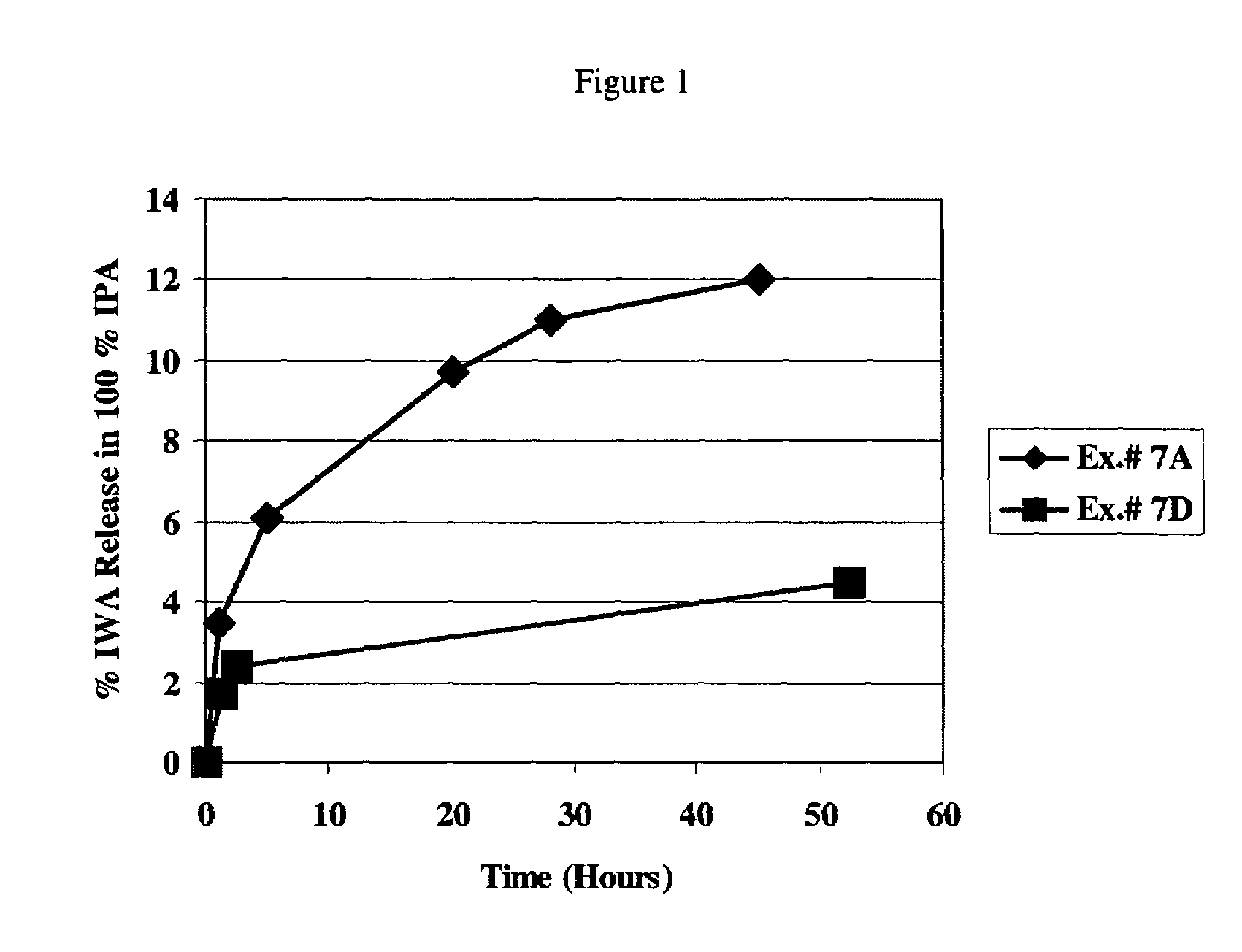Wettable hydrogels comprising reactive, hydrophilic, polymeric internal wetting agents
a technology of hydrophilic and reactive hydrogels, applied in the field of silicone hydrogels, can solve the problems of reducing the visual acuity of using these lenses, requiring extensive purification of each intermediate, and users' discomfor
- Summary
- Abstract
- Description
- Claims
- Application Information
AI Technical Summary
Benefits of technology
Problems solved by technology
Method used
Image
Examples
example 1
[0133]9-Vinylcarbazole (0.79 gm, 4.1 mmol) (Aldrich, Milwaukee, Wis.), 2,2′-Azobis[N-(2-carboxyethyl)-2-methylpropionamidine]tetrahydrate (0.16 gm, 0.46 mmol) (Wako Chemicals USA, St. Louis, Mo.) and freshly distilled N-vinyl-2-pyrrolidone (NVP) (15.1 gm, 136 mmol) were added to a 250 mL round bottom flask equipped with magnetic stirrer and nitrogen inlet. Methyl alcohol (19.2 gm) and distilled water (23.4 gm) were added to the reaction mixture. The mixture was degassed using 3 freeze-pump-thaw cycles and then allowed to warm to ambient temperature. The reaction mixture was heated at 60° C. for 16 hours, then precipitated three times using acetone as asolvent to yield a white polymer with Mn, Mw, and polydispersity values of 166,000, 420,000, and 2.6, respectively. Molecular weights were measured by gel permeation chromatography (GPC) using poly(2-vinylpyridine) standards and hexafluoroisopropanol as mobile phase. 1H NMR (D2O): =7.0-8.2 (bm, 8H, carbazole aromatic H), 3.4-3.8 (bm, 1...
example 2
[0134]9-Vinylcarbazole (Aldrich, Milwaukee, Wis.) (1.9 gm, 9.6 mmol), 2,2′-azobis[N-(2-carboxyethyl)-2-methylpropionamidine]tetrahydrate (Wako Chemicals USA, St. Louis, Mo.) (0.56 gm, 1.4 mmol) and freshly distilled N-vinyl-2-pyrrolidone (NVP) (52.8 gm, 475 mmol) were added to a 1 L round bottom flask equipped with magnetic stirrer and nitrogen inlet. Methyl alcohol (231.4 gm) was added to the reaction mixture. The mixture was degassed using 3 freeze-pump-thaw cycles and then allowed to warm to ambient temperature. The reaction mixture was heated at 60° C. for 4 hours, then isolated by precipitation (3 times) into diisopropyl ether to yield a white polymer with Mn, Mw, and polydispersity values of 30,000, 110,000, and 3.7, respectively, using poly(2-vinylpyridine) standards and hexafluoroisopropanol as mobile phase.
example 3
[0135]Polymer from Example 2 (27.0 gm, 239 mmol), DMAC (173 gm), 4-dimethylaminopyridine (DMAP, Avocado Research Chemicals, Heysham, England) (1.2 gm, 9.6 mmol), pyridine (20 mL), methacrylic anhydride (Aldrich, Milwaukee, Wis.) (7.43 g, 48.2 mmol) and hydroquinone (50 mg, 0.5 mmol, Aldrich, Milwaukee, Wis.) were charged to a 500 mL round bottom flask equipped with magnetic stirrer and nitrogen inlet. The reaction mixture was heated at 70° C. for 6 hours and then isolated by precipitation into diisopropyl ether (three times) to afford a white solid with Mn, Mw, and polydispersity values of 33,000, 109,000, and 3.3, respectively, using poly(2-vinylpyridine) standards and hexafluoroisopropanol as mobile phase.
PUM
| Property | Measurement | Unit |
|---|---|---|
| Mw | aaaaa | aaaaa |
| Mw | aaaaa | aaaaa |
| Mw | aaaaa | aaaaa |
Abstract
Description
Claims
Application Information
 Login to View More
Login to View More - R&D
- Intellectual Property
- Life Sciences
- Materials
- Tech Scout
- Unparalleled Data Quality
- Higher Quality Content
- 60% Fewer Hallucinations
Browse by: Latest US Patents, China's latest patents, Technical Efficacy Thesaurus, Application Domain, Technology Topic, Popular Technical Reports.
© 2025 PatSnap. All rights reserved.Legal|Privacy policy|Modern Slavery Act Transparency Statement|Sitemap|About US| Contact US: help@patsnap.com



